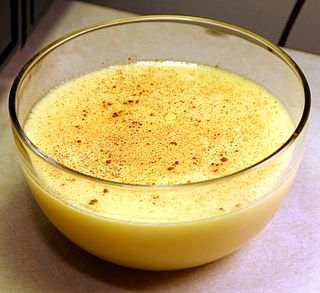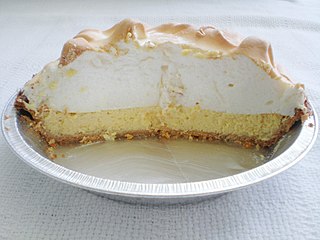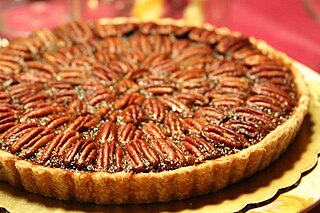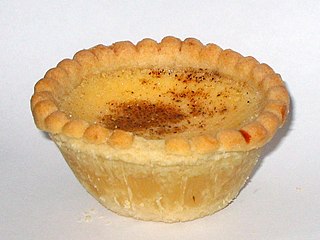
Dessert is a course that concludes a meal. The course consists of sweet foods, such as candy, and possibly a beverage such as dessert wine and liqueur. Some cultures sweeten foods that are more commonly savory to create desserts. In some parts of the world there is no tradition of a dessert course to conclude a meal.

Custard is a variety of culinary preparations based on sweetened milk, cheese, or cream cooked with egg or egg yolk to thicken it, and sometimes also flour, corn starch, or gelatin. Depending on the recipe, custard may vary in consistency from a thin pouring sauce to the thick pastry cream used to fill éclairs. The most common custards are used in custard desserts or dessert sauces and typically include sugar and vanilla; however, savory custards are also found, e.g., in quiche.

Pastry is baked food made with a dough of flour, water, and shortening that may be savoury or sweetened. Sweetened pastries are often described as bakers' confectionery. The word "pastries" suggests many kinds of baked products made from ingredients such as flour, sugar, milk, butter, shortening, baking powder, and eggs. Small tarts and other sweet baked products are called pastries as a synecdoche. Common pastry dishes include pies, tarts, quiches, croissants, and pasties.

A pie is a baked dish which is usually made of a pastry dough casing that contains a filling of various sweet or savoury ingredients. Sweet pies may be filled with fruit, nuts, fruit preserves, brown sugar, sweetened vegetables, or with thicker fillings based on eggs and dairy. Savoury pies may be filled with meat, eggs and cheese or a mixture of meat and vegetables.

Key lime pie is an American dessert pie. It is made of lime juice, egg yolks, and sweetened condensed milk. It may be served with no topping, topped with a meringue topping made from egg whites, or with whipped cream; it may be cooked in a pie crust, graham cracker crust, or no crust. The dish is named after the small Key limes, which are more aromatic than the common Persian limes, and which have yellow juice. The filling in a Key lime pie is typically yellow because of the egg yolks.

Chess pie is a dessert with a filling composed mainly of flour, butter, sugar, eggs, and sometimes milk, characteristic of Southern United States cuisine. It is similar to pecan pie without any nuts.

Lemon ice box pie is an icebox pie consisting of lemon juice, eggs, and condensed milk in a pie crust, frequently made of graham crackers and butter. It is a variant of key lime pie; in both, the citric acidity sets the egg yolks, with minimal baking. There are also no bake versions.

Pecan pie is a pie of pecan nuts mixed with a filling of eggs, butter, and sugar. Variations may include white or brown sugar, cane syrup, sugar syrup, molasses, maple syrup, or honey. It is commonly served at holiday meals in the United States and is considered a specialty of Southern U.S. origin. Most pecan pie recipes include salt and vanilla as flavorings. Pecan pie may be served with whipped cream, vanilla ice cream or hard sauce.

A cream pie, crème pie, or creme pie is a type of pie filled with a rich custard or pudding that is made from milk, cream, sugar, wheat flour, and eggs. It comes in many forms, including vanilla, lemon, lime, peanut butter, banana, coconut, and chocolate. One feature of most cream pies is a whipped cream topping. The custard filling is related to crème patissière, a key component of French cakes, and tarts. It is a one-crust pie, where the crust covers the bottom and sides but not the top. The crust may be a standard pastry pie crust, or made with crumbled cookies or a graham cracker crust.

Melktert is a South African dessert originally created by the Dutch settlers in the "Cape" consisting of a sweet pastry crust containing a custard filling made from milk, flour, sugar and eggs. The ratio of milk to eggs is higher than in a traditional Portuguese custard tart or Chinese egg tart, resulting in a lighter texture and a stronger milk flavour.

Custard tarts or flan pâtissier/parisien are a baked pastry consisting of an outer pastry crust filled with egg custard.

A lemon tart is a dessert dish, a variety of tart. It has a pastry shell with a lemon flavored filling.

Buko pie, sometimes anglicized as coconut pie, is a traditional Filipino baked young coconut (malauhog) pie. It is considered a specialty in the city of Los Baños, Laguna located on the island of Luzon.

Buttermilk pie is a pie in American cuisine. Associated with the cuisine of the Southern United States, it is one of the desperation pies, made using simple, staple ingredients.

Sponge cake is a light cake made with egg whites, flour and sugar, sometimes leavened with baking powder. Some sponge cakes do not contain egg yolks, like angel food cake, but most of them do. Sponge cakes, leavened with beaten eggs, originated during the Renaissance, possibly in Spain. The sponge cake is thought to be one of the first non-yeasted cakes, and the earliest attested sponge cake recipe in English is found in a book by the English poet Gervase Markham, The English Huswife, Containing the Inward and Outward Virtues Which Ought to Be in a Complete Woman (1615). Still, the cake was much more like a cracker: thin and crispy. Sponge cakes became the cake recognised today when bakers started using beaten eggs as a rising agent in the mid-18th century. The Victorian creation of baking powder by English food manufacturer Alfred Bird in 1843 allowed the addition of butter to the traditional sponge recipe, resulting in the creation of the Victoria sponge. Cakes are available in many flavours and have many recipes as well. Sponge cakes have become snack cakes via the Twinkie.
Pie in American cuisine has roots in English cuisine and has evolved over centuries to adapt to American cultural tastes and ingredients. The creation of flaky pie crust shortened with lard is credited to American innovation.

















